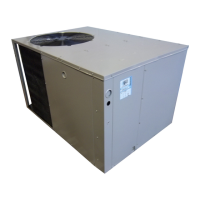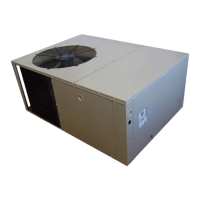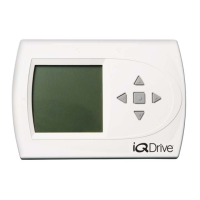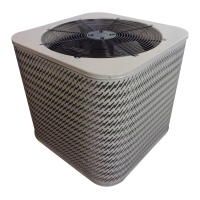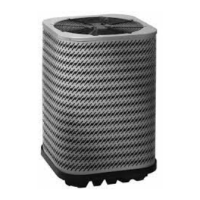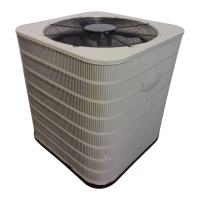11
START UP & ADJUSTMENTS
Before You Start the Unit
The following check list should be observed prior to
starting the unit.
Verify the unit is level and allows proper condensate
drainage.
Verify the outdoor coil and top of the unit are free from
obstructions and debris, and all equipment access/
control panels are in place. Unit must be installed with
the proper clearances as listed in Figure 2 (page 5).
Verify that the duct work is sealed to prevent air leakage.
Verify that the line voltage power leads are securely
connected and the unit is properly grounded. Check
the condenser fan to make sure it turns freely.
Verify the thermostat is wired correctly and installed
in a proper location. Make sure the low voltage wires
are securely connected to the correct leads on the low
voltage terminal strip.
Verify that the power supply branch circuit overcurrent
protection is sized properly.
Installing Initial Refrigerant Charge
IMPORTANT: Before you start unit, perform the following
procedures to install the initial charge on units that are
factory shipped with a nitrogen holding charge:
1. Read all installation instructions fi rst.
2. Purge the nitrogen holding charge.
3. Evacuate the unit to 350 - 500 microns.
4. Allow the unit to remain under vacuum for at least 30
minutes.
5. Inspect the unit rating plate for the proper type of
refrigerant and quantity.
6. Weigh in the proper amount of new (or reclaimed)
refrigerant.
Start-Up Procedure
The control circuit may consist of an anti-short cycle timer
that will not let the compressor re-start before 5 minutes
have elapsed.
1. Set the system mode to OFF and the temperature
mode to its highest setting.
2. Turn power on at the disconnect switch.
3. Set the system mode to ON or COOL.
4. Set the temperature mode below room temperature.
Verify that the indoor blower, outdoor fan, and
compressor energize and the cooling function starts.
5. Verify the discharge air grilles are adjusted and the
system air is balanced.
6. Verify the duct work has no air leaks.
7. Verify the condensate drain is installed correctly and
functions properly.
8. Set the temperature mode above room temperature.
The unit should stop.
9. Instruct the homeowner on unit and thermostat operation
and fi lter servicing.
System Cooling
Set the thermostat’s system mode to COOL and the
fan mode to AUTO. Change the thermostat temperature
selector below the existing room temperature. Allow the
cooling system to operate for several minutes and check
for the discharge of cool air at the supply registers. Verify
HI and LO refrigerant pressures.
FOR 3-Phase Models Only: If refrigerant pressures are
abnormal and the compressor is rotating backwards, shut
off main power to the unit and switch any two fi eld wires
at the disconnect. DO NOT alter unit wiring.
Short Cycle Protection
The control circuit may be equipped with a time-delay
feature for protection against short cycling. With the
system operating in the cooling mode, gradually raise the
thermostat temperature setting until the whole system de-
energizes. Immediately lower the thermostat temperature
to the original setting and verify that the indoor blower is
energized. After approximately 5 minutes the compressor
and the outdoor fan will energize.
Adjustment of Refrigerant Charge
CAUTION:
This air conditioner contains liquid and gaseous
refrigerant under pressure. Adjustment of
refrigerant charge should only be attempted
by qualifi ed, trained personnel thoroughly
familiar with the equipment and safe responsible
refrigerant handling procedures. Under no
circumstances should the homeowner attempt
to install and/or service this equipment. Failure
to comply with this warning could result in
equipment damage, personal injury, or death.
• To achieve rated capacity and effi ciency the compressor
must run for a minimum of 12 hours.
• The refrigerant charge can be checked and adjusted
through the service ports provided external to the
unit. Use only gage line sets which have a “Schrader”
depression device present to actuate the valve.
Charge Verifi cation for R-22 Units in AC Mode with
Outdoor Temperatures Above 55° F
1. With the system operating at steady-state, measure
the discharge refrigerant pressure in psig at the service
valve.
2. Measure the suction refrigerant pressure (psig) at the
service valve.
3. Determine the appropriate charge from the charts
(Figures 14 - 16, pages 16 - 17) for the discharge
temperature measured.
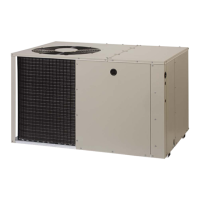
